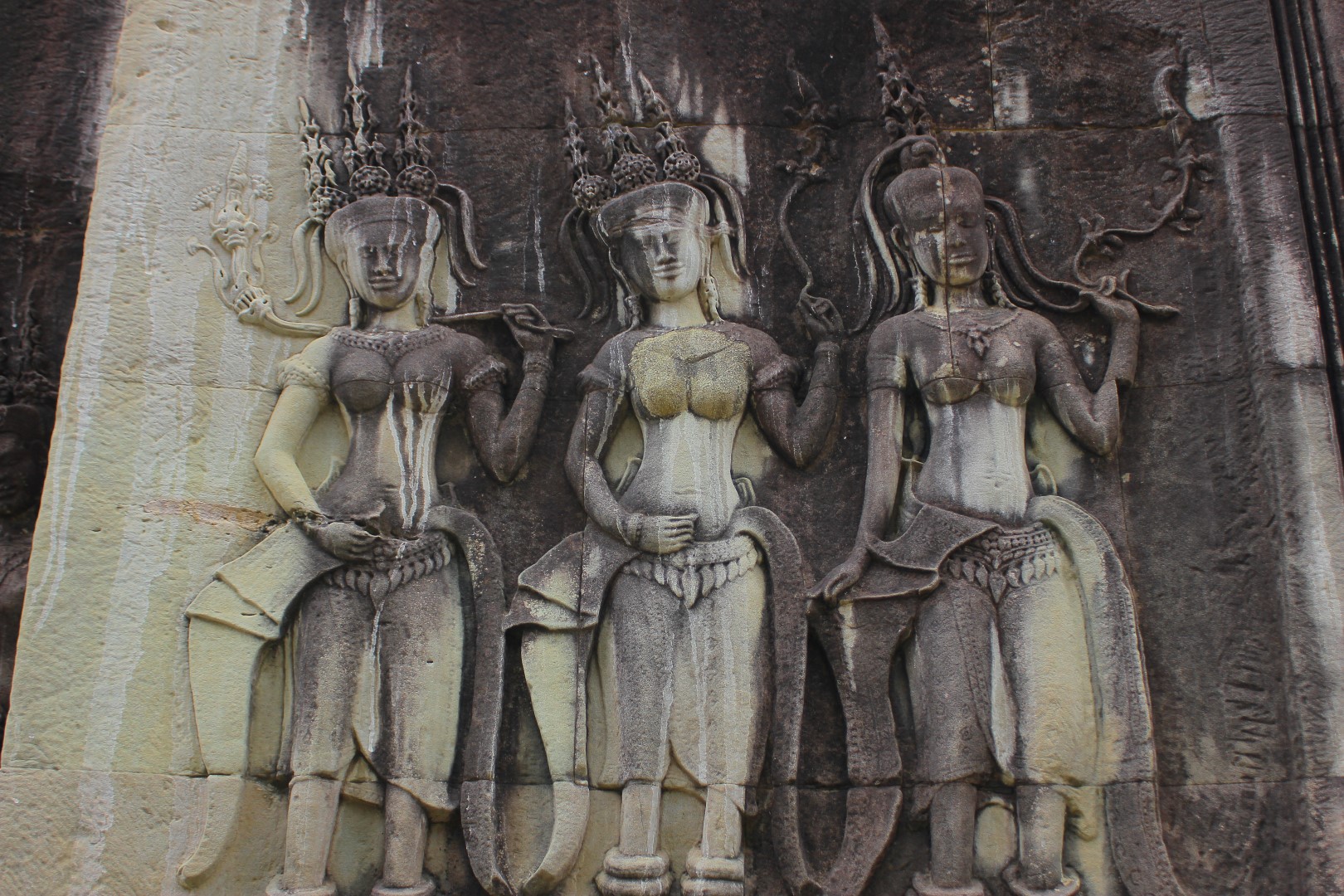
Awake early. Today’s the day. The Big Kahunas, I keep saying. Angkor Thom, Bayon and Angkor Wat. It feels an appropriate way to end our epic sightseeing tour in Cambodia.
Flash Angkor passes again, and break away from the rolling masses heading for Angkor Wat. We’re heading for the ancient city of Angkor Thom first. We pull over, in what I think is a strange place. The car putters off. Devid points ahead. A stone gate stands tall, with the serene smiling face of the Buddha on all four side of the tower. Cars, small buses and tuk tuks filter through the small opening at the bottom, single file. I recognise the gate from a photo in Nat Geo, which sparked my desire to visit. Devid strides out into the (slow moving) traffic and directs us to stand in front of the gate. No trouble from the waiting traffic – no one is in a rush. Slip through the gate with a couple on a scooter.
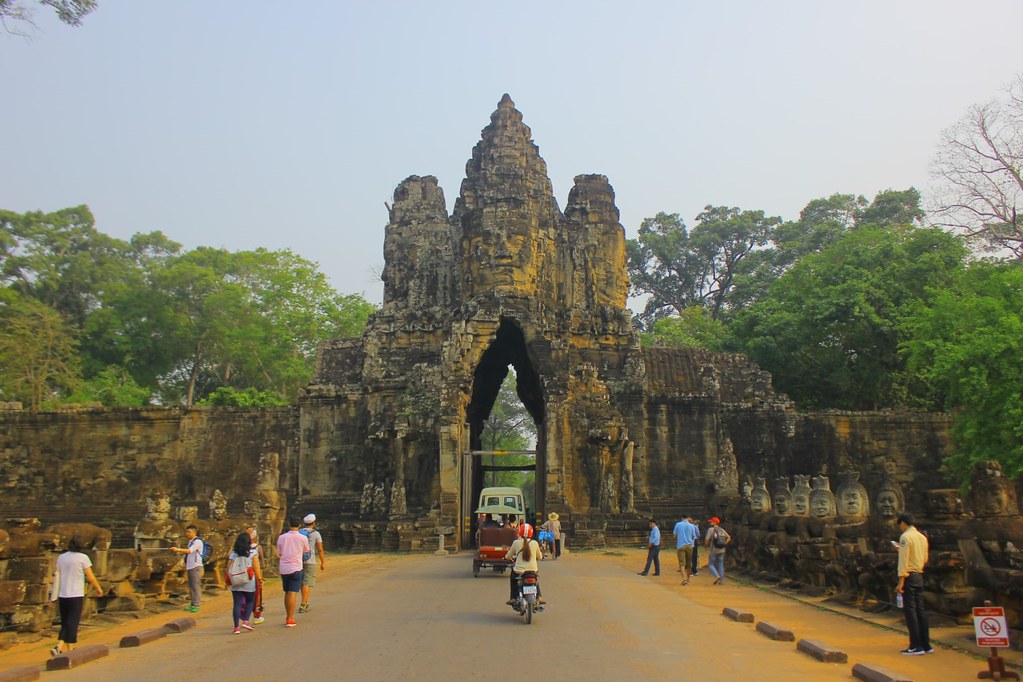
Back in the car, we continue on the road before pulling up near Bayon (which I point out like an excited child). Our driver lets us out and will meet us further on. We climb the steps to Bayon, the blooming cotton tree flowers falling like snow. Devid explained the complicated relief carving on the wall as we slowly filed past. Identical figures carved perfectly, one after the other, made up the scenes of the fairytale stories of Angkor kingdom. The panels reach high above my head. So high, I can’t make out the details of the other figures as they tower to the heavens.

Through the gallery, to the main tower. Everywhere you look, there is a face. Both stone and human. Tourists line up for the ubiquitous shot standing next a stone face, while as I turn circles looking up, every side of every tower smiles serenely down. It is impossible to overstate the grandeur of this temple. The stone is dark, blackened by the burning of the original forest overgrowth, and the rains have caused moss to grow, colouring the stones. It is everything you would expect from an Angkor temple; brooding and slightly ruined, invoking fantasies of reckless adventures discovering the temple for the first time.

We move on, walking leisurely through a bamboo plantation, stepping over random sandstone blocks, previously part of some grand design. Locals are walking in front, chattering excitedly and laughing. Devid explains that since it will soon be Songkran, the Khmer New Year, locals like to visit the temples to pray and chant for good luck and good health in the new year. Baphuon temple rises before us, a man made pyramid mountain whose top pokes out above the canopy of the surrounding cotton tree grove. It seems we are destined to climb a thousand stairs.
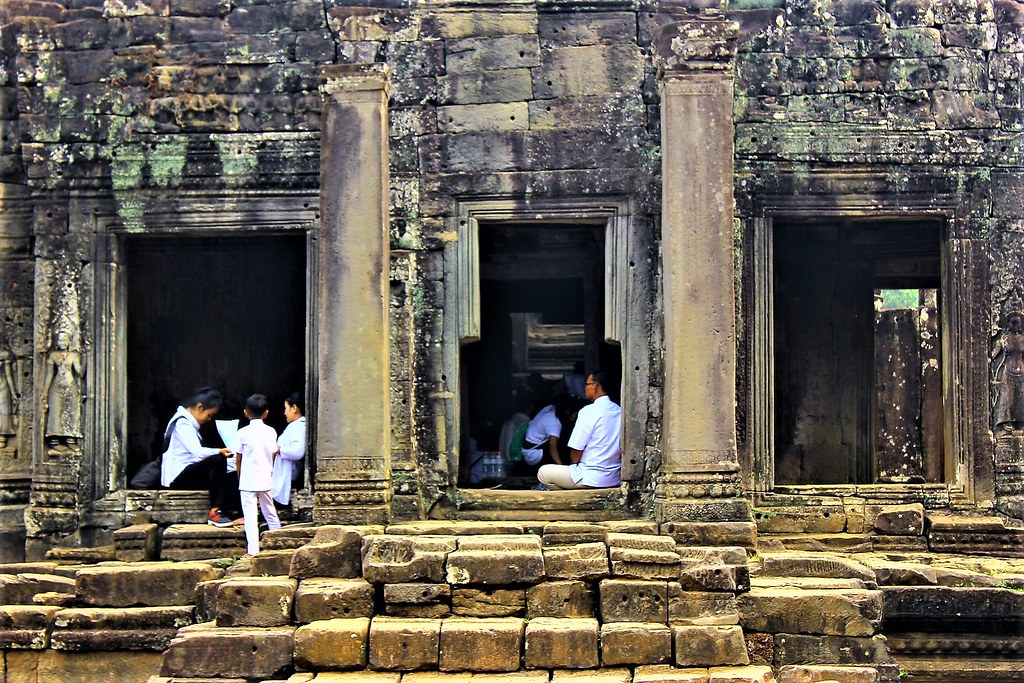
On top of the temple, having avoided the racket of beggar-guides on the lower level, we are treated an almost birds eye view of the temple grounds below. Parts of the covered walkway have fallen, opening the corridors up to the element. I don’t see the usual intricately carved walls and lintels, but Baphuon is still a marvel. Built on a man made island, a terraced mountain of stone, brick and sand. Perched on the top, and currently off limits, is the remnants of its tower. Long toppled, the only parts left are the steps and the door frames – an ancient stairway to heaven.
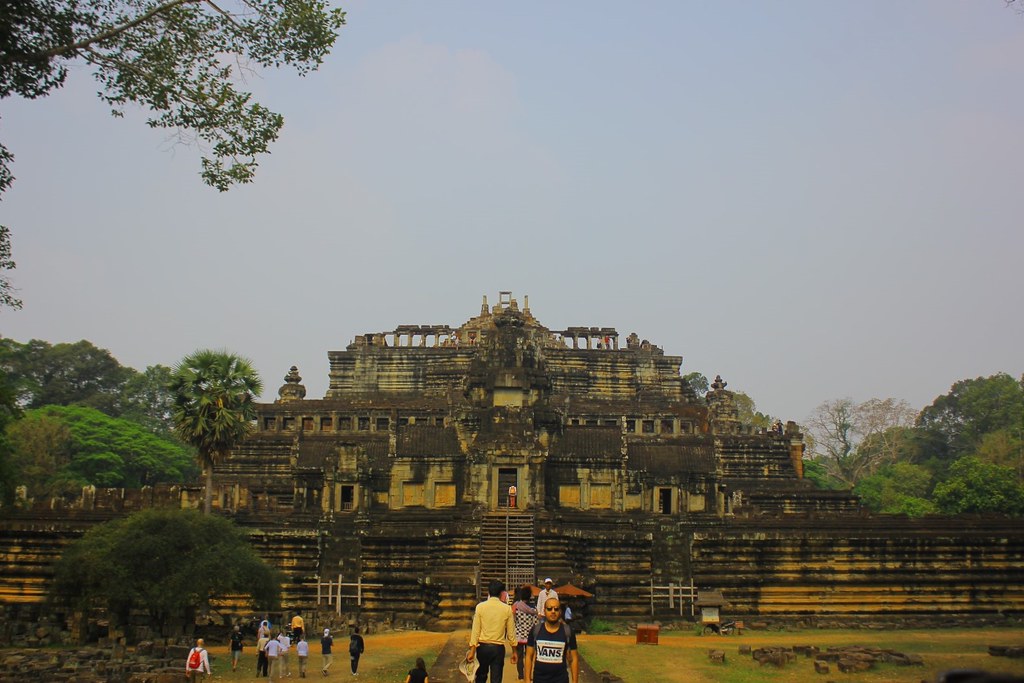
Descend the many stairs (a leg shaking exercise) and follow Devid as we wind our way through the cotton tree and mango tree grove. We walk through what would have once been royal palace of Angkor; all that is left now is a few smaller temples, marker stones and an enormous swimming pool. Devid is shy and giggles as he explain the ancient king built such a large pool to fit all his wives and concubines. Hubby’s hat attracts a butterfly who hitches a ride to the Terrace of Leper King.
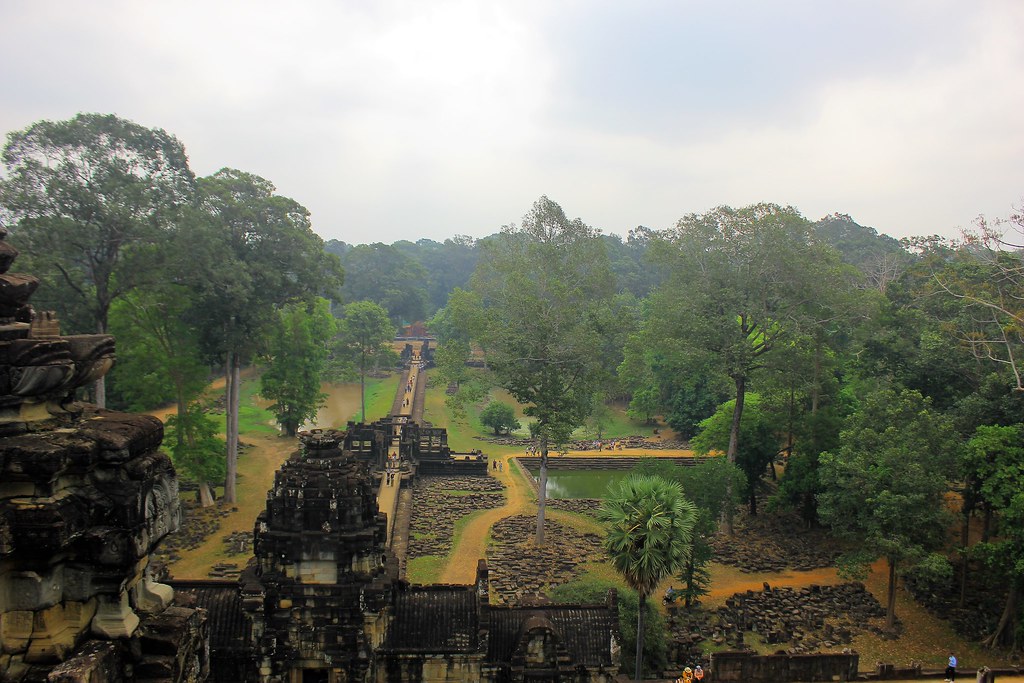
Wind our way through the ancient Terrace, past a mind boggling number of stone carvings. The earth is heaped up and it feels like I am walking through the middle of a hill. The hundred of faces peer back, watching my every move as I zig zag following the boardwalk. I lose Devid and hubby as they move ahead; I can’t help but stop and photograph as many of the faces as I can. Each one in a different state of ruin, some missing noses, some covered in moss, others in red sandstone. Despite the fact they would have been carved to look identical, they each have their own personality through the scars of history.

The tour buses are rolling into Angkor Thom. We meet up with our driver, and make tracks for Angkor Wat. Pull up in front of the restaurant where we had breakfast on our first day. Everything looks different in daylight; I’m less likely to trip over a stone today. Flash our passes again and head across the baray on the floating bridge, striding comically as the floor bounces and wobbles like a trampoline. Up the steps and through the gate, we march past the groups pouring out of the temple and head straight inside and hook a hard right.
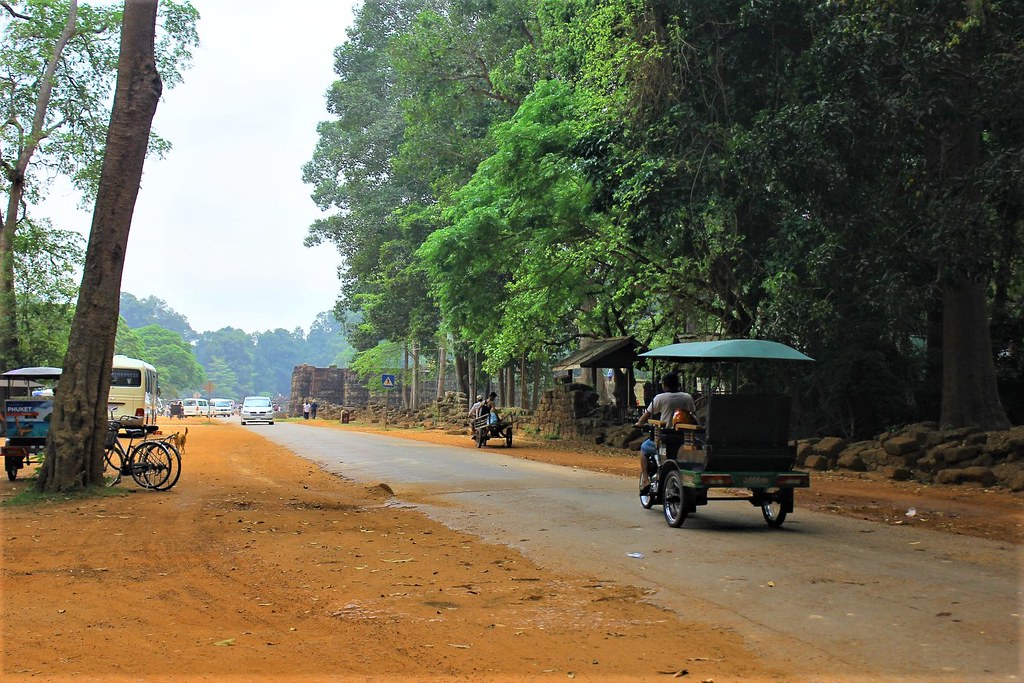
Angkor Wat’s enormous relief carvings take up entire sides of the lower level. Like many other temples we’ve seen this week, they tell the history of the Khmer empire interspersed with Hindu mythology. The detail is extraordinary, and I notice evidence of the gold leafing. The panels reach to the ceiling, and seem to go on forever. Devid explains the panels as we walk, but to be honest, I am so busy looking at everything and shooting that I only hear half of it. I notice by my feet, there is carvings of Hindu creatures at the base of every pillar. The ceiling is tiled in decorative patterns, and Khmer scripture is delicately etched in the doorways.
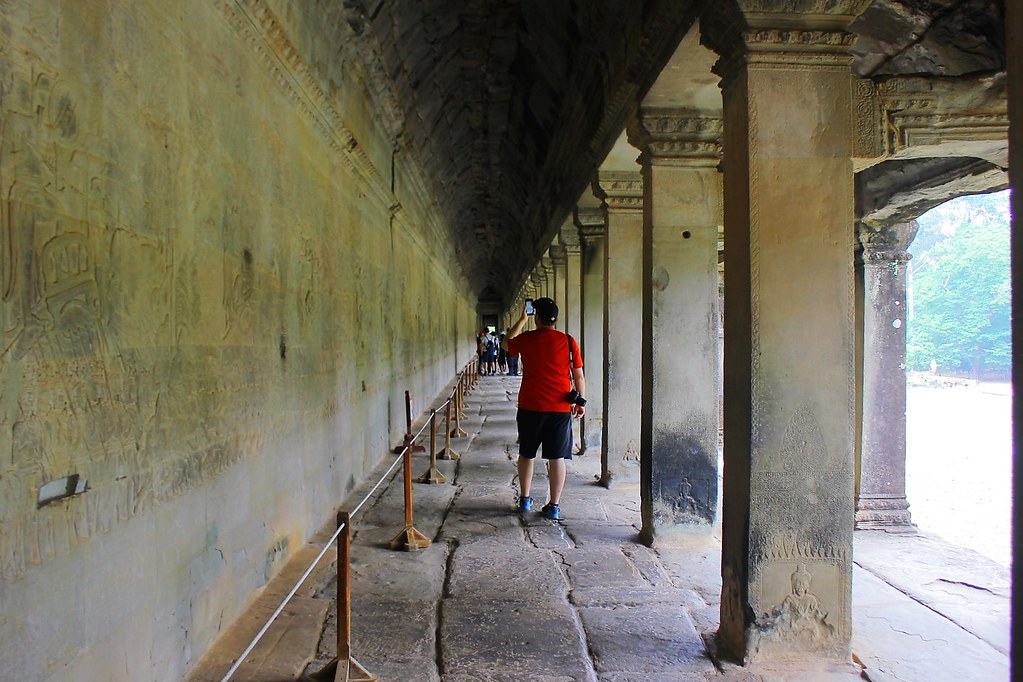
Into the cool shadows of another room. Apsaras carved into the walls disappear into the shadows overheard. Devid explains the temple changed colours as the years passed. Kings decided the walls should be black, red and finally leafed with gold as they took over the temple. Look close enough and you see tiny traces of these phases of the temple’s history. We seem to take endless turns and I think we zig-zag through the temple, before popping out in the inner courtyard. A staircase – thirty-seven steps, the thirty-seven steps to heaven in the local mythology.
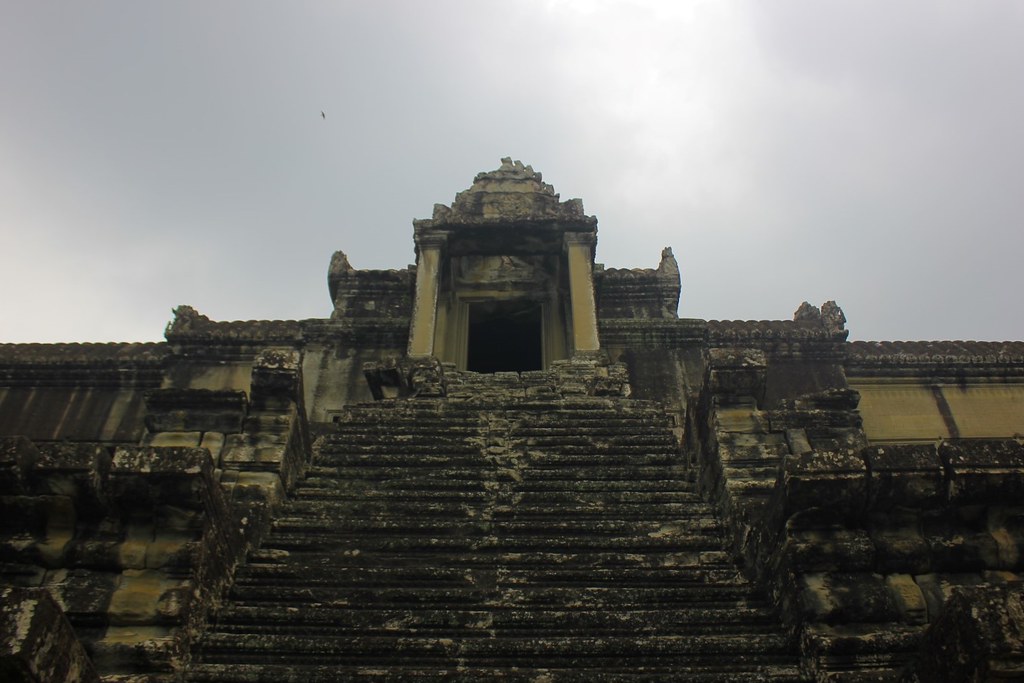
Up to the main tower, and I’m lost looking at the beautiful architecture of each tower. Locals filter past me, some stopping to snap a photo in the doorway. I spy some local dancers and musicians resting in the dark of a corridor, enjoying lunch and talking with each other. Devid says they perform dances in the temple, but they are now taking a break. We continue on, looking for the best angle in the large courtyard. Normally, you can climb the last set of stairs into the temple where the shrine is, however today is a holy day and this section is closed. Devid apologises, but we assure him that its no trouble – this is more than just a sightseeing circus for us Westerners.
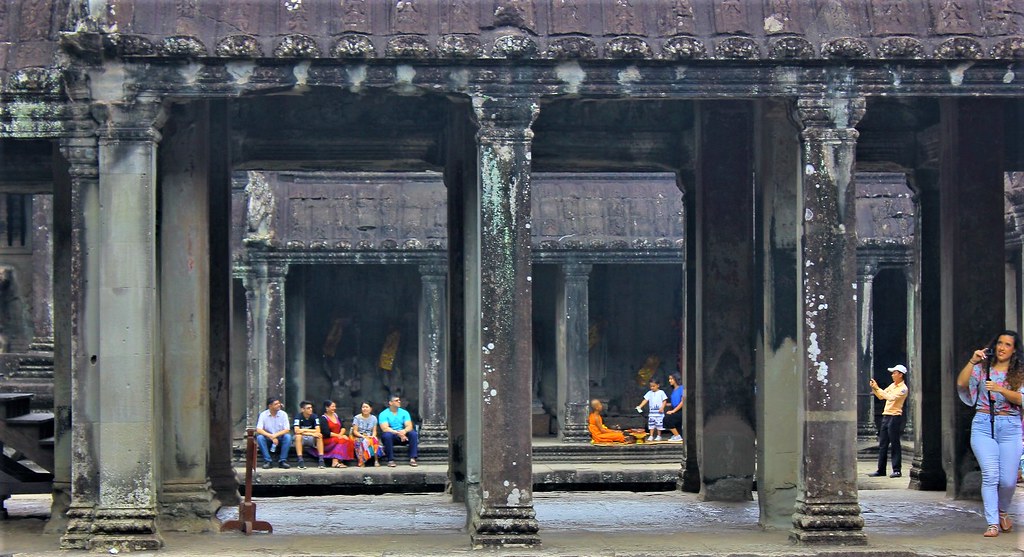
In the main hall, I watch an Indian couple pose for a photo near the old pools, which would have held the holy water for the temple. They are far more creative than I ever have been! I watch as locals and tourists alike approach a monk and receive a blessing. He sits so serenely on the stone floor, and its a picture perfect moment…. if I have my larger zoom lens. I remind myself that I am here, and I have witnessed this moment (very Buddhist of me). Looking up, I notice the original decorative carvings across the roof and beams. Still painted in saffron orange and red. Its effect is striking, and the more I look, the more I notice. It seems fitting of a temple that was once the centre of an ancient kingdom, and spent so long hidden. Understated, yet overwhelmingly beautiful.

Finally, having stood on the stone that marks the absolute centre of the Angkor Wat complex, we make our way out. Several couples are getting their pre-wedding photos taken in the grounds of Angkor Wat. This is wedding season, and Angkor Wat is one of the most popular settings for pre-wedding shoots. Assistants are furiously busy arranging the girls sarong, fixing their hair and fanning the silk scarves for creative effects. We’ve spent hours in here, looking and watching and taking photos. I want to capture as much as I can, making mental notes about what I see and trying to remember the facts that Devid has recounted to us. As we cross the baray, I skip a little – on purpose, not because I was bounced on the floating bridge. I have seen one of the wonders of the world.

Things to note:
- Once again, doing the temples in a reversed order – Angkor Thom first, then across to Angkor Wat, meant we were largely ahead of the bus tour groups and it wasn’t as busy.
- Look up and look down – there are wondrous details to be seen both at your feet and above your head.
- The stairs at Baphuon are not for the faint of heart. Take it slow, take it steady.
- Speaking of Baphuon… let me know if you spy the Reclining Buddha built into the back of the temple.
Have you enjoyed this diary series from Cambodia? You can find the rest of my entries under “Thoughts”.